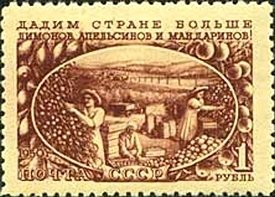Stamp: Citrus harvesting (Soviet Union, USSR 1951)
Citrus harvesting (Soviet Union, USSR 1951)
01 January (Soviet Union, USSR ) within release 25th Anniversary of Volkhov Hydroelectric Plant goes into circulation Stamp Citrus harvesting face value 1 Russian ruble
| Stamp Citrus harvesting in catalogues | |
|---|---|
| Michel: | Mi:SU 1568 |
Stamp is square format.
Also in the issue 25th Anniversary of Volkhov Hydroelectric Plant:
- Stamp - The dam and bas-relief of Lenin & Stalin face value 40;
- Stamp - Kakhovka Hydroelectric Power Plant face value 20;
- Stamp - Volga-Don canal's map and hydroengineering construstions face value 30;
- Stamp - Dam of Stalingrad Hydroelectric Power Plant face value 40;
- Stamp - Main Turkmen Canal [unbuilt] and cotton-plants face value 60;
- Stamp - Equestrian statue of Jan Žižka in Praha face value 20;
- Stamp - Monument to soldiers of Soviet Army in Ostrava face value 25;
- Stamp - Julius Fučík (1903-1943), Czechoslovak author face value 40;
- Stamp - Building of Bedřich Smetana Museum in Praha face value 60;
- Stamp - Volkhov Hydroelectric Plant named after V.I. Lenin face value 40;
- Stamp - Budapest: Liberty Bridge face value 25;
- Stamp - Budapest: Parliament face value 40;
- Stamp - Budapest: National Museum face value 60;
- Stamp - Combine harvester face value 25;
- Stamp - Meadow, grasses, insects and beehive face value 40;
- Stamp - Citrus harvesting face value 1;
- Stamp - M.I. Kalinin Museum in Moscow face value 20;
- Stamp - Mikhail I. Kalinin (1875-1946), Soviet statesman face value 40;
- Stamp - Felix E. Dzerzhinsky (1877-1926), Soviet statesman face value 40;
|
Data entry completed
43%
|
|
|---|---|
| Stamp Citrus harvesting in digits | |
| Country: | Soviet Union, USSR |
| Date: | 1951-01-01 |
| Format: | Stamp |
| Face Value: | 1 Russian ruble |
Stamp Citrus harvesting it reflects the thematic directions:
An economy is an area of the production, distribution and trade, as well as consumption of goods and services. In general, it is defined as a social domain that emphasize the practices, discourses, and material expressions associated with the production, use, and management of resources. A given economy is a set of processes that involves its culture, values, education, technological evolution, history, social organization, political structure, legal systems, and natural resources as main factors. These factors give context, content, and set the conditions and parameters in which an economy functions. In other words, the economic domain is a social domain of interrelated human practices and transactions that does not stand alone.
Agriculture is the cultivation and breeding of animals, plants and fungi for food, fiber, biofuel, medicinal plants and other products used to sustain and enhance human life.[1] Agriculture was the key development in the rise of sedentary human civilization, whereby farming of domesticated species created food surpluses that nurtured the development of civilization. The study of agriculture is known as agricultural science. The history of agriculture dates back thousands of years, and its development has been driven and defined by greatly different climates, cultures, and technologies. Industrial agriculture based on large-scale monoculture farming has become the dominant agricultural methodology.
In botany, a fruit is the seed-bearing structure in flowering plants (also known as angiosperms) formed from the ovary after flowering. Fruits are the means by which angiosperms disseminate seeds. Edible fruits, in particular, have propagated with the movements of humans and animals in a symbiotic relationship as a means for seed dispersal and nutrition; in fact, humans and many animals have become dependent on fruits as a source of food. Accordingly, fruits account for a substantial fraction of the world's agricultural output, and some (such as the apple and the pomegranate) have acquired extensive cultural and symbolic meanings. In common language usage, "fruit" normally means the fleshy seed-associated structures of a plant that are sweet or sour, and edible in the raw state, such as apples, bananas, grapes, lemons, oranges, and strawberries. On the other hand, in botanical usage, "fruit" includes many structures that are not commonly called "fruits", such as bean pods, corn kernels, tomatoes, and wheat grains. The section of a fungus that produces spores is also called a fruiting body.
A woman is an adult female human. Before adulthood, a woman is referred to as a girl (a female child or adolescent)
Flora is the plant life occurring in a particular region or time, generally the naturally occurring or indigenous—native plant life. The corresponding term for animal life is fauna. Flora, fauna and other forms of life such as fungi are collectively referred to as biota. Sometimes bacteria and fungi are also referred to as flora, as in the terms gut flora or skin flora.





